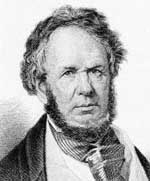Henry Rowe Schoolcraft

Henry Rowe Schoolcraft (* 28. März 1793 in Watervliet, Guilderland, Albany County, New York; † 10. Dezember 1864 in Washington D. C.) war ein US-amerikanischer Entdecker und Ethnologe, der bekannt dafür wurde die Quelle des Mississippi River im Jahre 1832 gefunden zu haben.
Die ersten Interessen von Schoolcraft waren Steine und Mineralien, die ihn 1820 zu einer geologischen Expedition zum Oberen See brachten. Anschließend war er Kartenhersteller und Staatsangestellter an der Northwest Frontier, nahe dem See Lake Superior. 1822 ging er als Indianeragent nach Michigan und wurde 1839 zum Hauptagenten der Indianer des nördlichen Departments ernannt. Im Jahre 1832 entdeckte er die Quelle des Mississippi in einem See in Nord-Minnesota den er Lake Itasca nannte, nach den lateinischen Wörtern caput (Kopf) und veritas (Wahrheit).
Schoolcraft interessierte sich auch für die amerikanische Urbevölkerung und schrieb über deren Geschichte, Sprache, Mythologie, Hieroglyphen, Bilder, Religionen usw. Sein Hauptwerk wird gebildet durch die nach einer Kongressakte unternommene und auf Kosten der Regierung herausgegebene Historical and statistical information respecting the history, condition, and prospects of the Indian tribes of the United States (6 Bde, 336 Kupfertafeln) Philadelphia (1851-1857).
1847 zog Henry Rowe Schoolcraft nach Washington, wo er am 10. Dezember 1864 starb.
Werke
- Travels in the central portions of the Mississippi valley. (1825)
- Narrative of an expedition through the Upper Mississippi to Itasca Lake. (1834)
- Algic researches. 2 Bde. New York (1839)
- The myth of Hiawatha and other oral legends. Philadelphia (1856)
- Oneota, or characteristics of the red race of America. New York (1844)
- The Indian in his wigwam. (1848)
- Notes on the Iroquois. Albany (1946)
- The red race of America. (1847)
- Personal memoirs of a residence of thirty years with the Indian tribes. Philadelphia (1851)
- Scenes and adventures in the semi-alpine regions of the Ozark Mountains. Philadelphia (1853)
| Personendaten | |
|---|---|
| NAME | Schoolcraft, Henry Rowe |
| KURZBESCHREIBUNG | US-amerikanischer Ethnologe und Entdecker der Quelle des Mississippis (1832) |
| GEBURTSDATUM | 28. März 1793 |
| GEBURTSORT | Watervliet, Guilderland, Albany County, New York |
| STERBEDATUM | 10. Dezember 1864 |
| STERBEORT | Washington (D. C.) |




